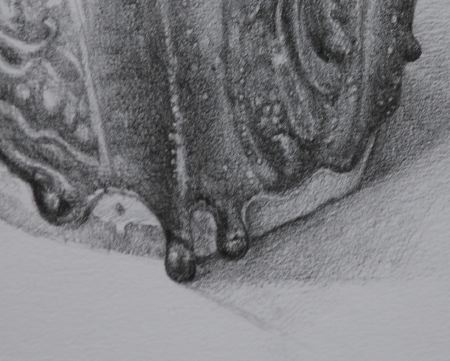
Here are the drawings I have been working on in the new year.
a multi-disciplinary dialog

In a recent post, Hanneke showed us a beautiful pencil drawing of three pears. In the comments, she and Karl expressed interest in comparing this drawing with a photograph. I decided to experiment along these lines, and above I’ve posted a first result (click on the image for a larger view). I plan to vary a number of factors involved in creating the image; you can help me decide what would be interesting to try.
In this first effort, I used one of Hanneke’s tricks: a dark background. The pears were ones I happened to have in the house, and are different from Hanneke’s, not as nice in shape. I used a similar arrangement to hers, with natural illumination from a nearby window. I’m not thrilled with my composition, but I didn’t take much time, and I can do a better job when I come back to this. Please give me your thoughts on things you like or don’t like about the composition.

Hanneke can’t post today and she asked me to fill in for her. I wanted to remark on an interesting trend in some of the comments about her work. For example, looking at an image of Old grapes, new painting, Colin Jago wrote “I seem to be looking down on the grapes and up at the glass.”
For Colorful Underpainting, Steve wrote “my first impression was that the cloth was somehow mounted on a wall. The bunch of grapes and the way they rest on it make this interpretation virtually impossible, of course, but I still don’t feel the correct perspective as strongly as I would like to.”
Hanneke paints her still life paintings “from life” and she tries to paint what she sees. Is she trying to show multiple viewpoints, or to produce distortion in perspective? Not intentionally, she has said. But is she doing so unintentionally?
Let’s take a look at Hanneke’s imaginary still life drawing and see if can find out more about the viewpoint issue.

In this imaginary still-life, the vessel is seen directly from the side, but the table top and fruit are seen from a different perspective, from above. We seem to look down on the table top while looking at the vessel from the side. This merging of different perspective points lends an interesting quality to the imaginary drawings. More examples of her “multiple viewpoint” imaginary drawings are here, here and here.
Let’s compare this to a drawing made directly from a real still life the same week when she made the imaginary drawings:

Do you see the difference? In this drawing from a real still-life, multiple viewpoints are not manifest. The fruit and the vessel are both seen from the same viewpoint.
I think that Colin and Steve are on to something with their comments about Hanneke’s painted still life work. In the “from life” still life paintings, the perspective may be technically correct, but she sometimes manages to produce a feeling of different viewpoints nonetheless. Would it be interesting if she tried to bring this difference in viewpoints more explicitly into her “from life” still life paintings? Or, should she work to correct the apparent flaw when it occurs?
Many people think of underpainting as a working in monochrome — either in grays, or browns. Artists of the past like Jan van Eyck used very colorful underpaintings. The usefulness of this I see in my painting of grapes.
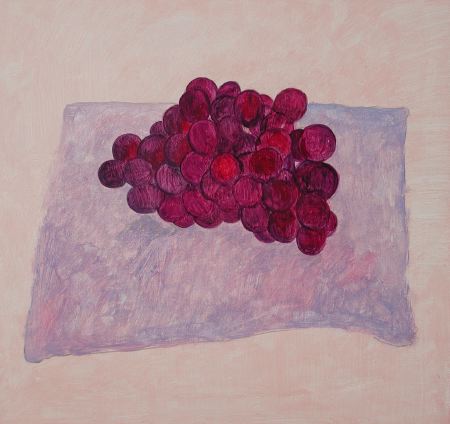
I was painting these grapes from some dark purple-blue grapes in my studio. I made the underpainting much more bright, and warm, than real grapes, as you can see in the picture above.
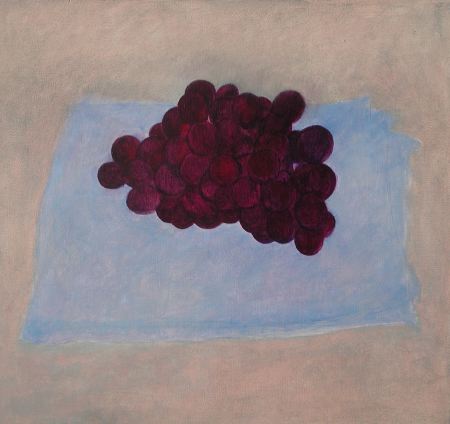
When the first layer of oil paint was dry, I began overpainting, putting darker shadows over the grapes to make the colors more realistic, darker and cooler, as you can see above.
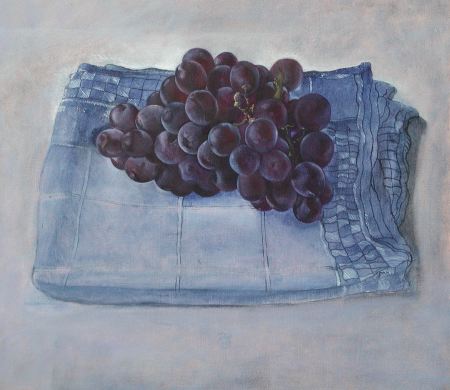
Here I have gone further with overpainting in another session. Now the grapes have a realistic color, but the brightness of the underpainting color shows through and gives life to the colors. If I had started with dark gray grapes, instead of a colorful underpainting, the colors would be dead when I did the overpainting. This this picture is not quite finished in the cloth. Here is where I left it yesterday afternoon.
Any suggestions?
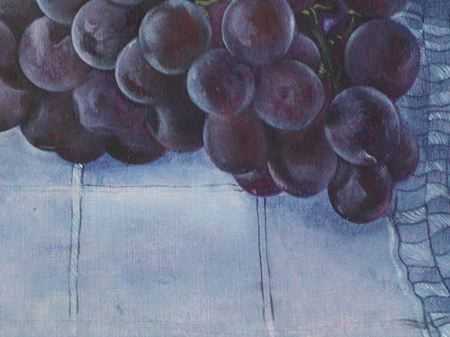
(detail requested by Steve)
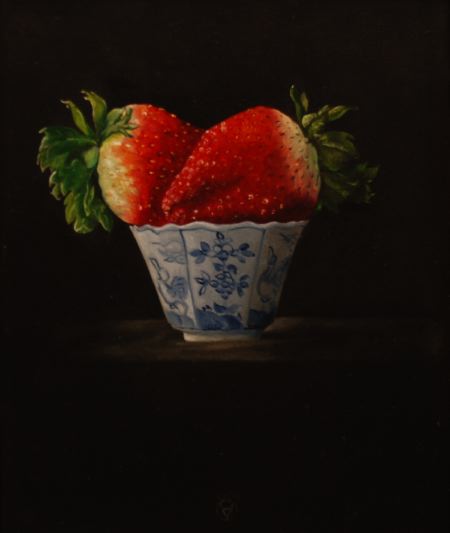
Artist and writer Jannie Regnerus has collected three paintings by my partner, Hanneke van Oosterhout. I went to Jannie’s house today to make a photograph of one of the paintings and to see if there was any chance that she would consider reselling them.

KARL ZIPSER: What do you think about these paintings you bought?
JANNIE REGNERUS: I like the intimacy of the painted objects. They have been cut off from their former lives as useful or functional things — especially the ginger pot. The ginger pot whispers its own history and has its own universe. The pears have a different feeling, they are sensual, almost like human bodies. And the strawberries have some humor because the proportions are confusing, the giant berries in the tiny cup.
KARL ZIPSER: Don’t you find these pictures a bit too dark?

JANNIE REGNERUS: I like the way the objects sink within this black background. They are very silent, but also very strong. I like these better than the paintings with the light background. Hanneke is very good in this dark and intimate night atmosphere. l like the tempered light, the sun has set, this is the best time for objects, they become more mysterious than they are in the broad daylight.
KARL ZIPSER: Would you sell these paintings? Perhaps you could buy something different, like a new stereo system?
JANNIE REGNERUS: Of course not. I bought them because I love them. I saw them and I wanted to have them close by. I didn’t buy them as an investment. When people come to my house they also want them. Hanneke made one picture for friends of mine who saw her work here. Every time I visit Hanneke’s studio I see new things, so it is very difficult for me to go there.
KARL ZIPSER: But you don’t like everything she makes.
JANNIE REGNERUS: Sometimes she works too long on a painting and I think that I liked it better at an earlier state. That is normal, it happens to me, I think it happens to every artist sometimes.
KARL ZIPSER: I agree, working too far is often a danger.
JANNIE REGNERUS: So Karl, what will be the prices of Hanneke’s paintings in the exhibition that begins this Friday?
KARL ZIPSER: That is an interesting question.
. . .
Hanneke’s show opens 15 December in Haarlem at gallery De Provenier (which does not have its own website). What will be the prices? Which pictures will she select for the exhibition? Will she, should she, sell on-line as well? All of these questions are unresolved. Hanneke will discuss the progress of the show on her own site.

Walter Bartman was my art teacher in high school in 1984-86 in Bethesda, Maryland. Students of “Mr. Bartman” were ten times more likely to become Presidential Scholars in Visual Arts than students in other art classes in the United States. Although he retired from high school teaching in 2001, Walter Bartman continues to teach landscape painting in Maryland and in workshops across the U.S. and in Europe.
Artwork in this post is plein air painting by Walter Bartman [click images to enlarge]. This interview was edited for publication together with Leslie Holt
more… »